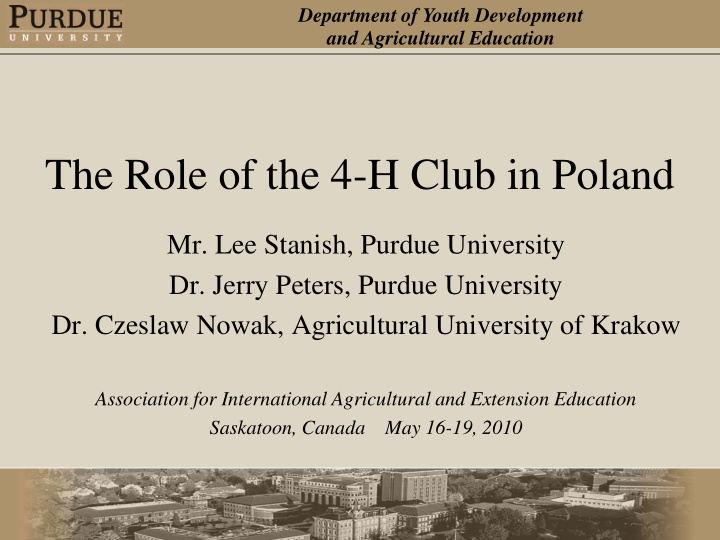



Department of Youth Development and Agricultural Education The Role of the 4-H Club in Poland Mr. Lee Stanish, Purdue University Dr. Jerry Peters, Purdue University Dr. Czeslaw Nowak, Agricultural University of Krakow Association for International Agricultural and Extension Education Saskatoon, Canada May 16-19, 2010
Department of Youth Development and Agricultural Education Introduction 4-H exists “Around the World”
Department of Youth Development and Agricultural Education Introduction 4-H in Poland 1920’s - Evolves to young farmer’s clubs 1991 - Encouraged by Polish-American Extension Project
Department of Youth Development and Agricultural Education Research Objectives 1) Describe basic characteristics of Polish 4-H in Swietokrzyskie Region of Poland 2) Explore the benefits of Polish 4-H in Swietokrzyskie Region of Poland 3) Contribute to international 4-H system research literature
Department of Youth Development and Agricultural Education Does 4-h Make a Difference? By Audience (youth, leaders, parents, teachers) By Program By System (state and national) Stakeholders of 4-H want to know!
Department of Youth Development and Agricultural Education Methods 4-H Affiliation Frequency % 4-H Member 167 71.4 4-H Alumni 23 9.8 4-H Parent 18 7.7 4-H Leader 12 5.1 Headmaster 6 2.6 Other 4 1.7 Total 230 100
Department of Youth Development and Agricultural Education Sample Findings Largely female (74.8%) Largely rural (89.7%) farm /country residence (53%) identified with 1-2 years of 4-H membership 28 participants had traveled on a 4-H exchange program to Michigan (5) or Indiana (23)
Department of Youth Development and Agricultural Education Characteristic Findings 1-2 hours per week was the time spent on 4-H projects by 67.5% of the sample (90.2%) of participants used their school as their 4-H meeting site (51%) of leaders were teachers in the school, (37%) students in the school
Department of Youth Development and Agricultural Education Characteristic Findings 4-H Project Focus Frequency % 186 79.5 Environment and Ecology Polish Arts and Traditions 174 74.4 Business Skills 102 43.6 Agriculture 94 40.2 Other 27 10.9
Department of Youth Development and Agricultural Education Quantitative Benefits’ Findings Activity Benefits Mean S.D. Do hands-on projects 1.25 .445 Make friends 1.38 .547 Become active in community service 1.47 .612 Become leaders in their local communities 2.15 .824 (1)Strongly Agree, (2)Agree, (3)Not Sure, (4)Disagree, (5)Strongly Disagree
Department of Youth Development and Agricultural Education Quantitative Benefits’ Findings Subject Benefits Mean S.D Ecology 1.01 .148 Working as a team 1.22 .433 Polish Traditions 1.42 .630 Communicating Ideas 1.43 .603 Polish Art 1.64 .689 Solving Problems 1.68 .708 Leadership 2.06 .872 Improving English Communication 2.5 1.116 Skills Improving English Writing Skills 2.68 1.091
Department of Youth Development and Agricultural Education Quantitative Benefits’ Findings 83% participants felt 4-H improves students’ grades in school
Department of Youth Development and Agricultural Education Qualitative Benefits’ Findings “ What do you feel you have gained from being involved with 4 ‐ H in the Swietokrzyskie Voivodship”? #1 Content #2 Life Skills #3 Polish 4-H Attributes
Department of Youth Development and Agricultural Education Qualitative Benefits - #1 Content Theme Polish culture, history, traditions (N=92) Ecology and Environment (N=67)
Department of Youth Development and Agricultural Education Qualitative Benefits – #2 Life Skills Theme Making Friends (N=92) Educational Excursions (N=52) * Organizing leisure time of youth*
Department of Youth Development and Agricultural Education Qualitative Benefits – # 3 Attributes Theme Builds local pride Is a “real adventure” for youth Clubs are “very popular” Has “positive influences on young people” Gave me “good memories” Allowed me to “discover my hidden talents” Provided the opportunity to “cooperate with teens and with the local community”
Department of Youth Development and Agricultural Education Conclusions Polish 4-H System Characteristics Perceived Social and Educational Benefits International 4-H literature review Policy and Funding Implications
Department of Youth Development and Agricultural Education Further Research Methodologies Other Voivodships (16) Non- 4-H or 4-H dropout audience Gender questions in Polish 4-H Case Study
Recommend
More recommend